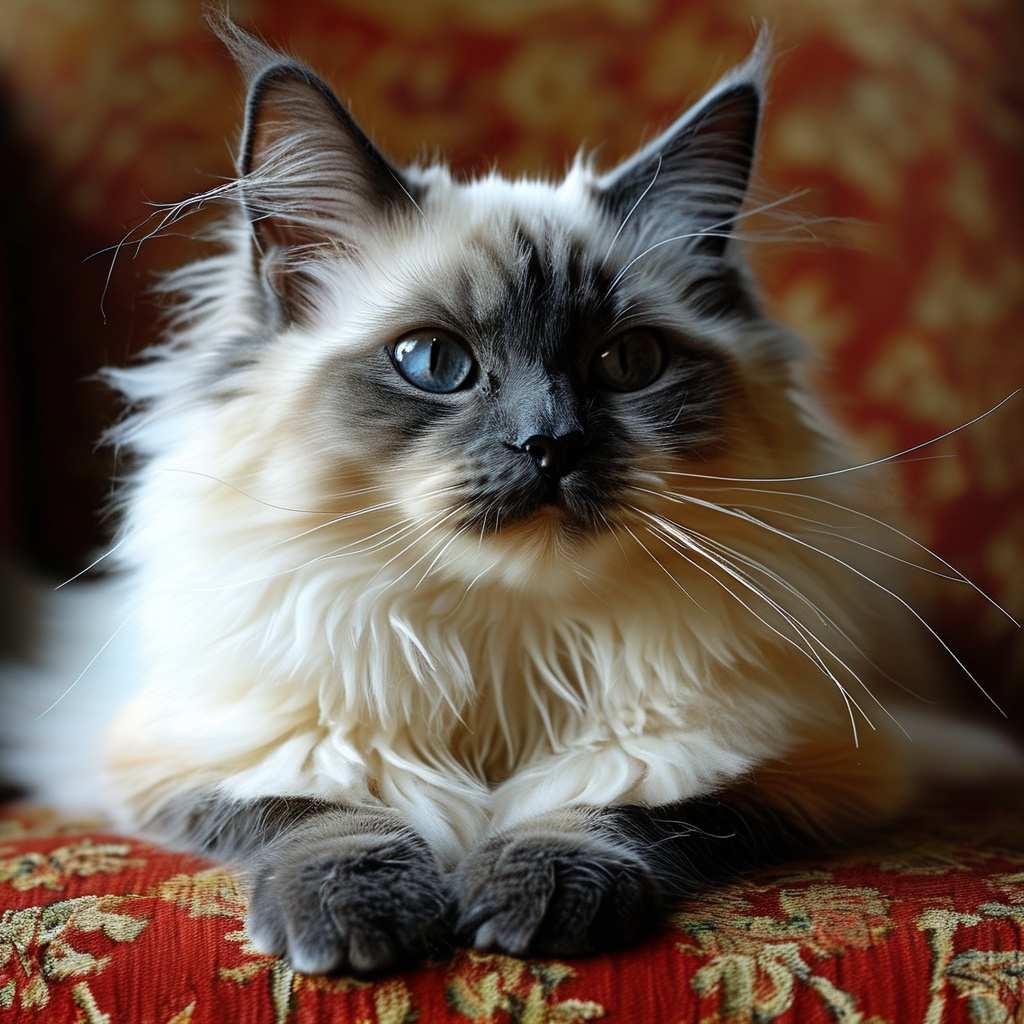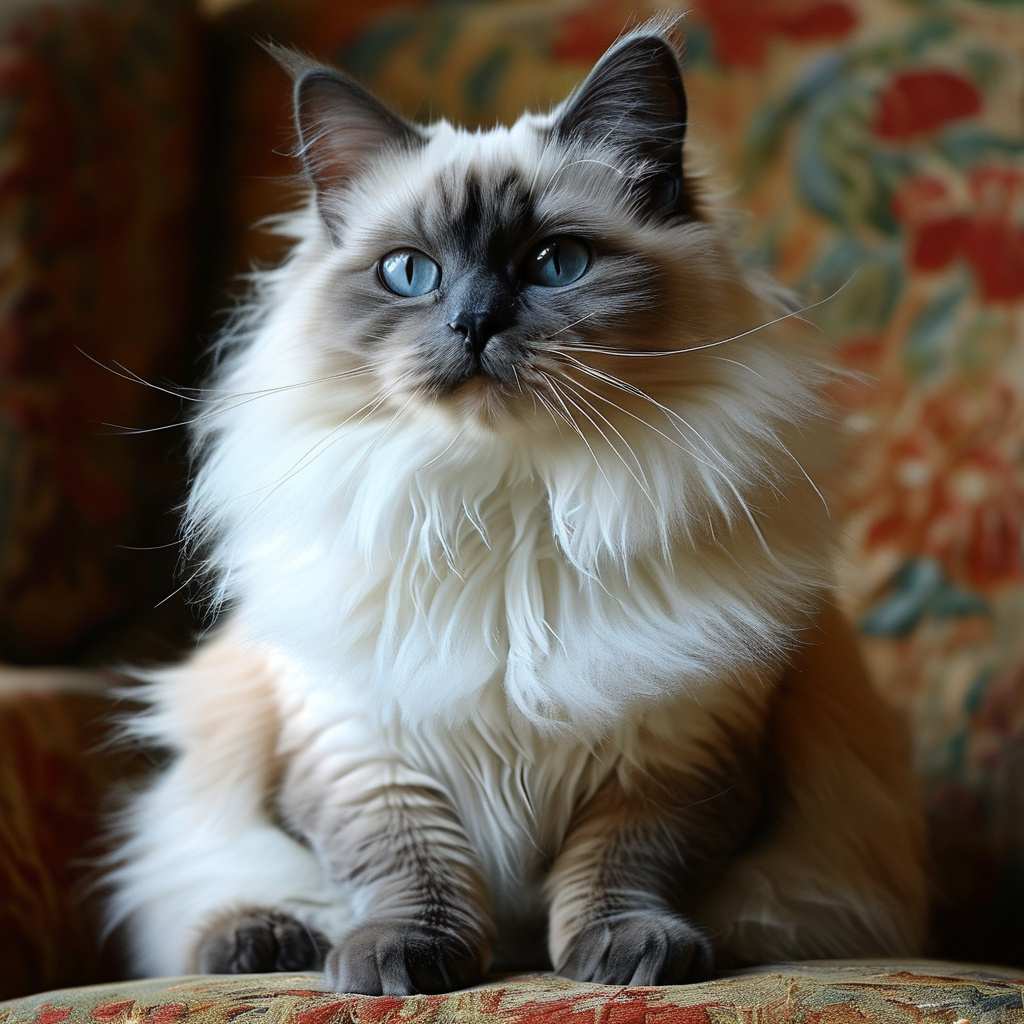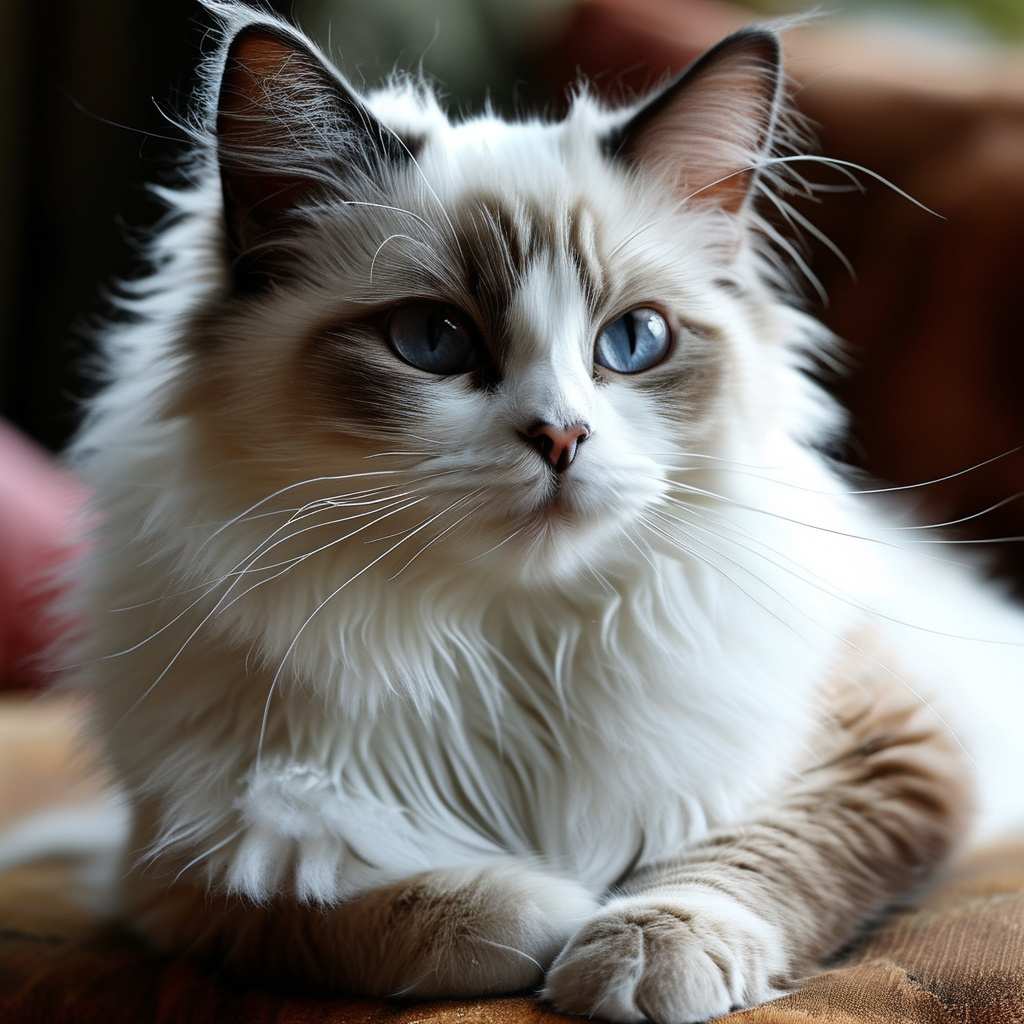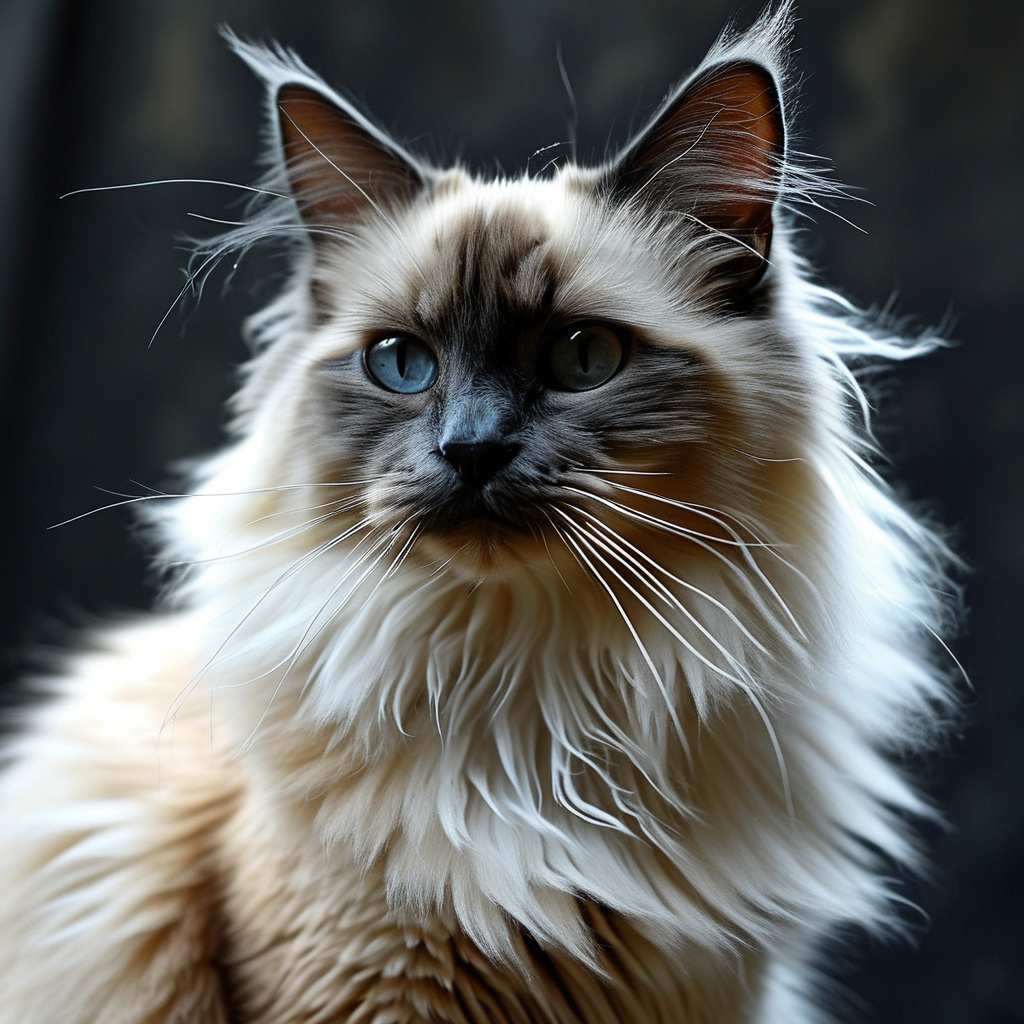
Introduction:
The Ragdoll cat is a unique and captivating breed, known for its large size, striking blue eyes, and affectionate nature. Emerging from a curious history that dates back to the 1960s in California, the origins of the Ragdoll are shrouded in controversy and mystery. With an appearance influenced by several breeds, including Persian and Burmese, these cats are famous for their docility and the way they become limp, like a ragdoll, when held. Their laid-back temperament and bond with humans make them ideal companions, especially for families with children or those seeking a gentle, sociable feline friend.
Related Post: The Unique Charm of Thai Cats: A Return to the Original Siamese Look
Ragdoll – Breed Characteristics
The Ragdoll is one of the largest and most mysterious of all domestic cats. The history of the breed’s origin is still controversial and undoubtedly worthy of attention.
Related Post: How to Choose and Introduce Dog Clothing: A Guide for Pet Owners
 The events described below took place in California, USA, in the 1960s. Cat lover Ann Baker found a white cat that had been hit by a car and looked like a cross between an Angora and a Persian. Josephine, as Ann named the cat, recovered and gave birth to a litter of kittens characterized by complete muscle atrophy. The kittens became completely lethargic when held by humans, hence the name of the breed – Ragdoll. The owner of the litter and the cat began to experiment again with the reproduction of this unique breed, combining and crossing different specimens until, in her opinion, they reached perfection. Thus, among the ancestors of the Ragdoll are Burmese, Burmese, and Persian cats. It is not entirely clear where the first litter of kittens came from, and Ann Baker herself has told various stories, such as the mutated genetic code of a female cat or even the help of aliens in the creation of the breed.
The events described below took place in California, USA, in the 1960s. Cat lover Ann Baker found a white cat that had been hit by a car and looked like a cross between an Angora and a Persian. Josephine, as Ann named the cat, recovered and gave birth to a litter of kittens characterized by complete muscle atrophy. The kittens became completely lethargic when held by humans, hence the name of the breed – Ragdoll. The owner of the litter and the cat began to experiment again with the reproduction of this unique breed, combining and crossing different specimens until, in her opinion, they reached perfection. Thus, among the ancestors of the Ragdoll are Burmese, Burmese, and Persian cats. It is not entirely clear where the first litter of kittens came from, and Ann Baker herself has told various stories, such as the mutated genetic code of a female cat or even the help of aliens in the creation of the breed.
These cats came to Europe only in 1981 and were recognized by FIFe in 1992.
Related Post: The Power of Cuddling: Building Bonds Between Humans and Animals
Ragdoll – Silhouette
Ragdolls are large and muscular domestic cats. Adult body weight can be up to 10 kg (usually about 8 kg) for males and 4 to 6 kg for females. However, this breed grows quite slowly, reaching full physical maturity at the age of 3-4 years.
The animals have a sloping posture due to their hind legs being slightly longer than the forelegs – the hind legs are higher than the forelegs. The head is medium-sized, broad and wedge-shaped, with rounded ears set fairly wide apart. The cheeks are well-defined, and the chin is firm. The eyes should be oval, large and definitely blue, preferably the darkest possible shade. The neck is short but strong. These cats have a long body and a pronounced chest. The tail is long and fluffy, tapering slightly towards the tip. The legs of this breed are medium long, but the paws are large, round, and have tufts between the fingers.
Related Post: The Energetic and Stubborn Yorkshire Terrier: A Complete Guide
 There are three different colour types for this breed: mitted, colourpoint, and bicolour, and each type can occur in 10 different colours. The mitted type of coat is only possible in Ragdolls; it is the “socks” variety. It is characterized by a white stripe running from the chin to the base of the tail. In colour points, the paws, tail, and ears are significantly darker than the rest of the body. In colours, the entire belly, paws, and chest must be white.
There are three different colour types for this breed: mitted, colourpoint, and bicolour, and each type can occur in 10 different colours. The mitted type of coat is only possible in Ragdolls; it is the “socks” variety. It is characterized by a white stripe running from the chin to the base of the tail. In colour points, the paws, tail, and ears are significantly darker than the rest of the body. In colours, the entire belly, paws, and chest must be white.
Grooming
The semi-long, silky coat of this breed is extremely easy to groom. The coat is virtually free of undercoat and does not tend to clump or tangle. The coat on the neck and tail is longer. It is worth combing the coat every few days to keep it clean and beautiful. This treatment, if both parties enjoy it, will strengthen the bond between the cat and the groomer. The best way to comb your cat is with a metal comb with long, closely spaced teeth. However, if a cat is reluctant to be groomed for any reason, it will be very difficult to get him to do it. It is worth rewarding your pet after each grooming session to ensure that he develops positive associations with it. This should be done gently but firmly so that the tips of the comb reach the skin.
Bathing is not recommended for Ragdolls; it should only be done on the recommendation of a veterinarian or if the cat is too dirty to clean itself.
Like all cats, Ragdolls should be fed a balanced, meat-based diet. This will ensure a shiny coat, healthy skin, and good condition. In later life, these cats can be prone to weight gain, so it’s important to monitor your pet’s body weight and choose the right type of food.
 Health issues
Health issues
Ragdolls are more prone to genetic diseases due to the high affinity rate in the breed. However, a thorough check of the breeding facility can help prevent future health problems. The breeder is required to provide documentation of tests, examinations, and their results.
Due to the size of the body, one of the most common diseases that Ragdolls suffer from is Hypertrophic Cardiomyopathy. In addition, these cats are predisposed to diseases of the urinary system (cystic stones), gums and periodontium (eosinophilic gingivitis), or joints (mucopolysaccharidosis). It is a good idea to have your cat checked regularly by your veterinarian to ensure your cat’s good health.
The average lifespan of a Ragdoll cat is 15 to 19 years.
Temper
Although knowledge of the breed is growing, the myth that these cats do not feel pain persists. Their extraordinary docility, patience, and calm may have contributed to these rumours. However, Ragdolls feel pain and discomfort just like any other animal.
Ragdolls are incredibly attached to their people and adapt to their lifestyle. They are known for their canine nature. Their intelligence, as well as their curiosity and interest in everything, allows them to learn many tricks, and retrieving is a standard game with Ragdolls. These elegant animals are ideal candidates for families with children and for cat therapy. That’s because of their gentleness, sociability and mental immunity. It’s very difficult to make them nervous; they will react with flight rather than aggression. They love children, other cats and even other species.
The main sound we hear from Ragdolls is loud purring, and what’s interesting is that instead of meowing, they make sounds more like the crying of a small child. Because of their trusting nature and eagerness to be petted, they should not be left alone. Ragdolls are comfortable in an apartment or house. Adults are typically ground-dwelling and naturally quiet. They do not tend to jump on furniture or curtains.
Despite its short history, this breed has captured the hearts of cat lovers around the world. This is due to their unusually gentle disposition and angelic appearance, which, combined with their willingness to play with their caregiver, is an unusual combination – the members of this breed make ideal friends.
Conclusion:
The Ragdoll cat has quickly earned a reputation as one of the most loving and easygoing breeds in the world of felines. Its angelic appearance, calm nature, and playful personality create a perfect blend for those seeking a loyal and gentle companion. However, their trusting demeanor makes them vulnerable, requiring attentive care and companionship. Whether lounging in a peaceful apartment or playing fetch, these elegant cats are more than just a pretty face—they’re devoted friends for life. Their gentle hearts and mysterious past have cemented their place in the hearts of cat enthusiasts everywhere.
FAQs:
1. Why are Ragdolls called “Ragdoll” cats?
Ragdolls get their name from their unique tendency to go completely limp, like a ragdoll, when picked up. This characteristic comes from their relaxed, docile nature.
2. What are the three types of Ragdoll coat patterns?
Ragdolls have three coat patterns: mitted, colourpoint, and bicolour. Mitted Ragdolls feature a white stripe and “socks,” colourpoints have darker paws, tails, and ears, while bicolours display white bellies, paws, and chests.
3. What health issues are common in Ragdoll cats?
Ragdolls are prone to conditions like hypertrophic cardiomyopathy, urinary system issues, gum diseases like eosinophilic gingivitis, and joint disorders. Regular vet check-ups are essential for maintaining their health.
4. How should I groom a Ragdoll cat?
Ragdolls have a semi-long, silky coat that is easy to groom. Combing every few days with a metal comb helps keep their coat clean and tangle-free, particularly around the neck and tail.
5. Are Ragdolls suitable for families with children or other pets?
Yes, Ragdolls are excellent for families with children and other pets. They are gentle, sociable, and rarely show aggression, making them ideal companions in multi-pet households.
6. Do Ragdoll cats meow like other cats?
Interestingly, Ragdolls tend to make sounds resembling a baby’s cry rather than typical cat meows, and they are known for their loud purring rather than frequent vocalizing.
7. How long do Ragdoll cats typically live?
Ragdolls have a relatively long lifespan, averaging between 15 to 19 years, provided they receive proper care, a balanced diet, and regular vet visits.
References: